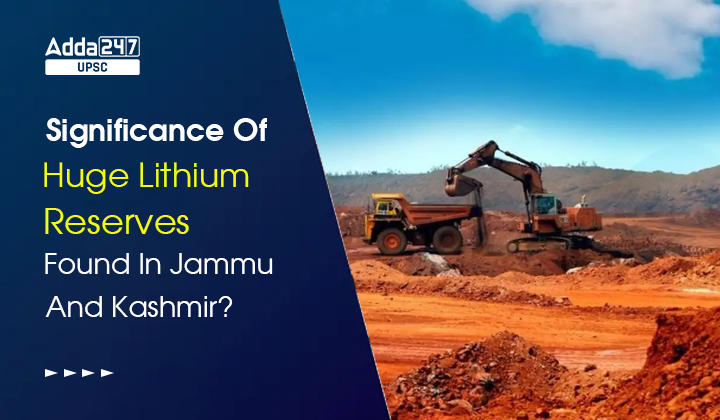Table of Contents
Significance Of Huge Lithium Reserves In Jammu And Kashmir?
In this article, ”Significance Of Huge Lithium Reserves In Jammu And Kashmir?”, we will discuss about Significance Of Lithium, Worldwide EV Revolution, Distribution Of Lithium Reserves, India’s Progress To Find Lithium Reserves, etc.
Huge Lithium Reserves In Jammu And Kashmir: In News?
Recently, the Geological Survey of India established 5.9 million tonnes of inferred lithium resources in the Salal-Haimana area of Reasi District in Jammu and Kashmir.
Significance Of Lithium
Lightest and Least Dense: This grey, shiny, non-ferrous metal is the lightest and the least dense of all metals.
Highly Reactive: Being the third element in the periodic table after gases hydrogen and helium, the alkali metal lithium is highly reactive.
White Gold: Multiple countries have ramped up efforts to find reserves of lithium, sometimes dubbed ‘white gold’, in what has been called the “new era gold rush”.
Huge Demand: From about 500,000 metric tonnes (MT) of lithium carbonate equivalent (LCE) in 2021, the demand for lithium is expected to reach three million to four million MT in 2030.
Why Is Lithium In Such Demand?
Worldwide EV Revolution
- Besides being used in batteries to power smartphones, laptops and other gadgets, lithium is an essential component in the rechargeable batteries that run electric vehicles (EVs) and in storage batteries for energy from renewable sources.
- Lithium is used in electric car batteries because of its properties— lightness and energy density.
- As countries move toward clean energy technologies to meet their Paris Agreement climate pledges, the transition to electric vehicles is key as vehicular pollution accounts for a significant proportion of carbon emissions.
- The U.S. plans to make 50% of its new vehicle fleet electric by 2030.
- The EU in October approved a ban on the sale of new petrol and diesel cars from 2035. India has also set a target of 30% sales penetration of EVs in private cars and 80% in two- and three-wheelers by 2030.
No Alternate of Lithium
- Lithium is an essential part of virtually all electric vehicle batteries and those used in consumer electronics.
- While some new mixes like sodium ion batteries are being developed, lithium ion batteries are expected to remain the dominant battery chemistry.
Other Uses Of Lithium
- While lithium is also used in ceramics, in industrial grease, and in the pharmaceutical sector, its potential demand is expected to be largely driven by batteries.
Distribution Of Lithium Reserves
- Lithium is currently extracted from two main sources—hard rock mines or as brine from salt flats and lakes, from where it is recovered using evaporation tanks.
- According to the U.S. Geological Survey, while identified lithium resources worldwide stood at 89 million tonnes at the start of 2022, the reserves or mineable parts of the resources stood at 22 million tonnes.
- Half of the world’s lithium resources are concentrated in Latin America (mostly Bolivia, Chile, and Argentina), Australia, and China. In 2021, almost 90% of lithium mining happened in Chile, China, and Australia, with Australia leading production.
| Important Fact
In 2019, the Nobel Prize in Chemistry was given to John B. Goodenough, M. Stanley Whittingham and Akira Yoshino for their contributions to the development of the lithium-ion battery. |
How India Fulfills Its Demand For Lithium?
- Currently India is fully import-dependent when it comes to lithium.
- While the Centre has launched incentives for battery manufacturing in India, raw materials like lithium have so far been imported.
- In 2022, between April and November alone, ₹164 crore worth of metal and ₹7,986 crore worth of batteries were imported.
- This means that if the currently established lithium resources by the GSI are confirmed, India could see its dependence on imports go down significantly.
India’s Progress To Find Lithium Reserves
- According to GSI, the lithium deposits in Kashmir could hold a whopping 5.9 million tonnes of lithium. This is the G3 level of surveying.
- According to the Ministry of Mines, the GSI has carried out 19 projects in the last five years on “lithium and associated elements”.
- Of these, three of the projects have progressed from the G4 to the G3 level, and one to G2. These are in the Reasi district of J&K (the newly discovered estimate), and in Sirohi district and Nagaur district of Rajasthan.
- The one that has progressed to the G2 classification is the Rewat Hill block, also in Rajasthan.
What are different levels of surveying?
-
- As per the United Nations Framework Classification (UNFC), a basic, reconnaissance survey is called ‘G4’; the next step is ‘preliminary exploration’, which is called G3.
- Then comes general exploration, or G2. And when quantities associated with a known deposit “can be estimated with a high level of confidence”, the stage is called G1.
What Next?
- A lot of steps are involved before India could become a producer of Lithium.
- First, the GSI would have to conduct further exploration to determine if there are mineable reserves in the estimated 5.9 million resources in Jammu and Kashmir.
- This would be followed by tendering and environmental clearances for mines.



 TSPSC Group 1 Question Paper 2024, Downl...
TSPSC Group 1 Question Paper 2024, Downl...
 TSPSC Group 1 Answer key 2024 Out, Downl...
TSPSC Group 1 Answer key 2024 Out, Downl...
 UPSC Prelims 2024 Question Paper, Downlo...
UPSC Prelims 2024 Question Paper, Downlo...




